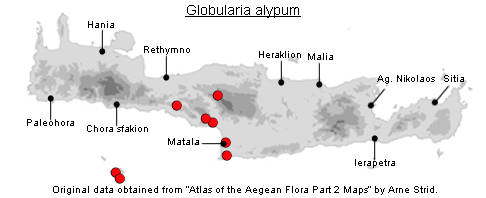SPECIES DESCRIPTION
GLOBULARIA ALYPUM
Family and Genus:- See- PLANTAGINACEAE
Common Name:- Shrubby globularia
Homotypic Synonyms:- None
Meaning:- Globularia (L) Globe.
Alypum (L) A former synonym for Globularia.
General description:- Shrub, Young twigs and leaves with abundant calcareous
secretions.
Stems:-
1) Up to 150(-200) cm. ascending to erect, branched, especially below, glabrous or
sometimes glandular-hairy in the inflorescence.
Leaves:-
1) Oblanceolate to obovate, mucronate or the apex 3-dentate, coriaceous, short
petiolate, uniformly distributed on the main stems, fasciculate, on short, non-
flowering lateral branches.
Flowers:-
1) Lilac-blue, borne in globose heads, 10-25mm diam., mostly terminal, fragrant,
2) Corolla, with a single 3-lobed lip, sometimes with sessile axillary capitula below
them.
3) Involucral bracts, broadly ovate, obtuse, sometimes mucronate, ciliate, densely
imbricate and forming a ruff below the flower-heads.
4) Calyx-teeth, about twice as long as the tube, setaceous, long-ciliate.
Key features:-
1) Shrub, with erect or procumbent woody branches.
2) Twigs, leafy up to the inflorescence.
3) Never rooting at the nodes.
Habitat:- Constituent of dry open shrubby vegetation, scrubland vegetation and as
undergrowth in open pinewoods on rocky hillslopes. 0-500(-900) m.
Distribution:- Fairly widespread throughout the Mediterranean. Rare on Crete,
known only from the Gulf of Mesara region and Gavdos island off the south-western
coast.
Flowering time:- (Oct-) Jan-Apr.
Photo by:- Yannis Zacharakis
